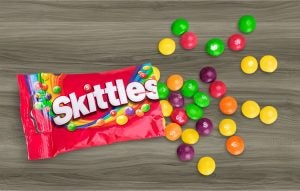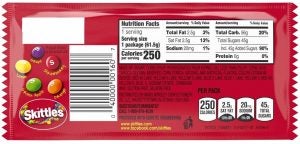In a lawsuit seeking class-action status filed in U.S. District Court for the Northern District of California recently, attorneys for San Leandro resident Jenile Thames said that Skittles were unsafe for consumers because they contain “heightened levels” of titanium dioxide (TiO2), according to USA Today.
Thames is suing candymaker Mars Inc., alleging that Skittles contain a “known toxin” that makes them “unfit for human consumption.” The lawsuit claims that the company “has long known of the health problems posed” by TiO2. It states that in February 2016, the company “committed to phasing out” the TiO2 in its product but has yet failed to do so, according to NBC’s TODAY.
The lawsuit notes that the toxin was banned in France in 2019 and that the company announced it would comply with the country’s law. Just last May, the European Food Safety Authority (EFSA) determined that TiO2 “could not be considered safe for consumption,” prompting the European Commission’s announcement that it would “adopt a ban on the use of TiO2 as a food additive.”
Per the lawsuit, the company continues to use TiO2 in the product in the U.S. and has failed “to inform consumers of the implications of consuming the toxin.” The document claims consumers “are at heightened risk of a host of health effects for which they were unaware stemming from genotoxicity — the ability of a chemical substance to change DNA.”
The lawsuit also claims that Thames would not have purchased the Skittles if he had known it contained TiO2. He alleges that the ingredients on the candy are difficult to read due to the contrast in color between the font and packaging.

All right, there’s a lot to unpack here. Of course, what a lawsuit claims and what the scientific evidence shows don’t always match up. Similarly, the decision by Mars in 2016 to phase out TiO2, among other artificial colors, doesn’t mean that there is evidence of toxicity or that it was due to known health problems. In many cases, companies phase out specific ingredients for marketing purposes. If there is an ingredient with negative consumer perceptions and alternatives that have more positive consumer perceptions, in this case natural colors, a company may switch purely for marketing purposes and increased consumer acceptance. Another reason why a company may switch could be due to an ingredient ban in specific countries. It may make sense to change all formulations so that they can have a consistent product among many different countries.
So, it cannot be inferred that there is evidence of harm just based on the fact that they pledged to remove it. Trix cereal tried out the switch from artificial to natural colors for a period of time before switching back to artificial when they learned consumers were not in favor of the new look.
It also cannot be deduced that for any given ingredient that there is evidence of harm to humans at doses in foods just because a country or countries have made the decision to ban it. In the case of TiO2, the EFSA came to the conclusion that “E 171 can no longer be considered as safe when used as a food additive.” However, this isn’t due to evidence of harm, rather their opinion after evaluating the evidence was that “a concern for genotoxicity could not be ruled out.”
This is much different than the lawsuit claim that TiO2 is a “known toxin.”
It’s important to note that other regulatory agencies have come to a much different conclusion than the EFSA and disagree with their conclusions. In the U.S., per the U.S. Food and Drug Administration’s Code of Federal Regulations, “The color additive titanium dioxide may be safely used for coloring foods generally subject to the following restrictions: The quantity of titanium dioxide does not exceed 1 percent by weight of the food.”
In a statement sent by Mars to TODAY and several other news outlets, the company said: “While we do not comment on pending litigation, our use of titanium dioxide complies with FDA regulations.”
It’s not only the FDA that does not align with the EFSA’s conclusions. After reviewing the evidence, the UK’s Food Standards Agency said no safety concerns have been identified, so there will not be a change to regulation in England and Wales. Food Standards Scotland also reached the same conclusion. The Food Standards Agency’s scientific advisory committees reviewed the EFSA opinion and found that the evidence did not support the conclusions made.
The EFSA Opinion was presented to the Committee on Mutagenicity of Chemicals in Food, Consumer Products and the Environment (COM) in June of 2021 and to the Committee on the Toxicity of Chemicals in Food, Consumer Products and the Environment (COT) in July of 2021. The Committee on Mutagenicity questioned the quality of the dataset and robustness of some of the studies used by the EFSA panel to draw its conclusions:
“Members considered that the evidence did not allow definitive conclusions to be drawn and therefore they did not agree with the overall conclusions on the genotoxicity of E171 Titanium dioxide. They considered that a more reliable and robust dataset would be required before any conclusions could be drawn on the on the mutagenicity of TiO2 particles. Members noted that EFSA made no clear distinction between the genotoxicity of nano-sized and microsized titanium dioxide particles. EFSA seemed to have put a lot of emphasis on the evidence from nano-sized particle evidence when nanoparticles made up only a small fraction of E171. The COM suggested that that if practicable, restricting the amount of nanoparticles in the specification for E171 might reduce any potential genotoxicity risk. Additionally, the COM considered that the wording of EFSA’s conclusion was not helpful from a risk communication perspective. Due to the heterogenous data and equivocality of the evidence further refinement of the data evaluated may be needed before definitive conclusions on the genotoxicity and safety of titanium oxide could be made. Currently, the EFSA conclusions were not justifiable based on the available evidence and this may create unnecessary concern for the public.”
The Committee on the Toxicity agreed with the comments of the Committee on Mutagenicity with regards to risk communication that, “As it stands the conclusion is highly risk adverse based on the weak evidence available, and it might create unnecessary concern to the public.”
They were uncomfortable with the EFSA’s binary communication on a dataset with a lot of uncertainties.
As far as the lawsuit’s claim that the product in the U.S. and has failed “to inform consumers of the implications of consuming the toxin.” Well first, as laid out above, the actual scientific evidence doesn’t back the “toxin” claim. Additionally, he claimed that the ingredients on the candy are difficult to read due to the contrast in color between the font and packaging. Here’s a picture of the back of a package of original Skittles:

I’ll keep my followers updated as far as what happens with this lawsuit, but either way it’s important to remember to always read past the headlines and regardless of the outcome, the current scientific evidence doesn’t back the claim that Skittles contain a “known toxin” that makes them “unfit for human consumption.”
Food Science Babe is the pseudonym of an agvocate and writer who focuses specifically on the science behind our food. She has a degree in chemical engineering and has worked in the food industry for more than decade, both in the conventional and in the natural/organic sectors.



